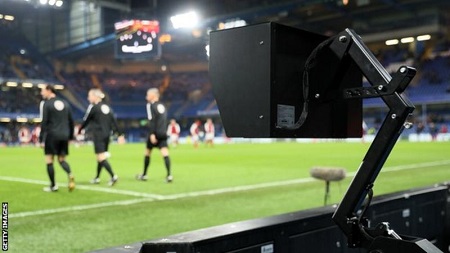England's top flight is one of the last high-profile competitions to get on board with the VAR (video assistant referee system).
VAR has been gradually introduced into most major domestic leagues in the world over the past two years and been used in the Champions League from 2017-18, the 2018 World Cup in Russia and this summer's Women's World Cup in France.
Seen by many as a natural and necessary progression for modern football (video replays are already an integral part of sports such as cricket, tennis and both codes of rugby), it also has its detractors, who fear it could slow the game down and reduce its spontaneity and passion.
So what can Premier League fans expect from VAR next season? And how will the league ensure this step into modernity is as seamless and efficient as possible?
The key thing to know is the Premier League's guiding principle for VAR is that it be used for "clear and obvious errors" and "serious missed incidents" in four types of match-changing incidents:
- Goals - whether they should stand or not based on potential violations (fouls, offside, etc) in the build-up.
- Penalties - whether the referee has made the correct decision in either awarding one or not.
- Straight red cards - did an incident on the pitch receive the correct punishment from the referee?
- Mistaken identity - when a referee awards a yellow or red card to the wrong player following an on-field incident.
Keen to preserve the fast pace for which the competition is heralded, the Premier League says that while it will adhere to broader VAR protocol - laid out by world football's law-making body, the International Football Association Board (IFAB) - it has its own nuanced interpretations on the technology's application.
Its aim is to preserve the overriding authority of the on-field referee and achieve "minimum interference" to the game.
Key to both principles is the ongoing, match-long dialogue between the on-field official and their video assistant, much of which occurs in the background without players or supporters being overtly aware.
VAR automatically checks all key incidents during a game, but the video officials' role will be informed by their on-field colleague, who describes to them what they have seen and why they have reached their conclusion.
It is only if the replays show a different version of events to that described by the on-field referee that the VAR team will step in. The on-field referee will then decide whether to accept and act on the VAR official's view of the incident. This may involve the use of the pitch-side monitor, although the Premier League says this will be used sparingly, for incidents either not seen by the on-field ref or for those outside of their expected range.
READ ALSO:
- Solskjaer in 'no doubt' Pogba will stay at Manchester United
- Jordan Ayew features in Crystal Palace defeat
Source: bbc





